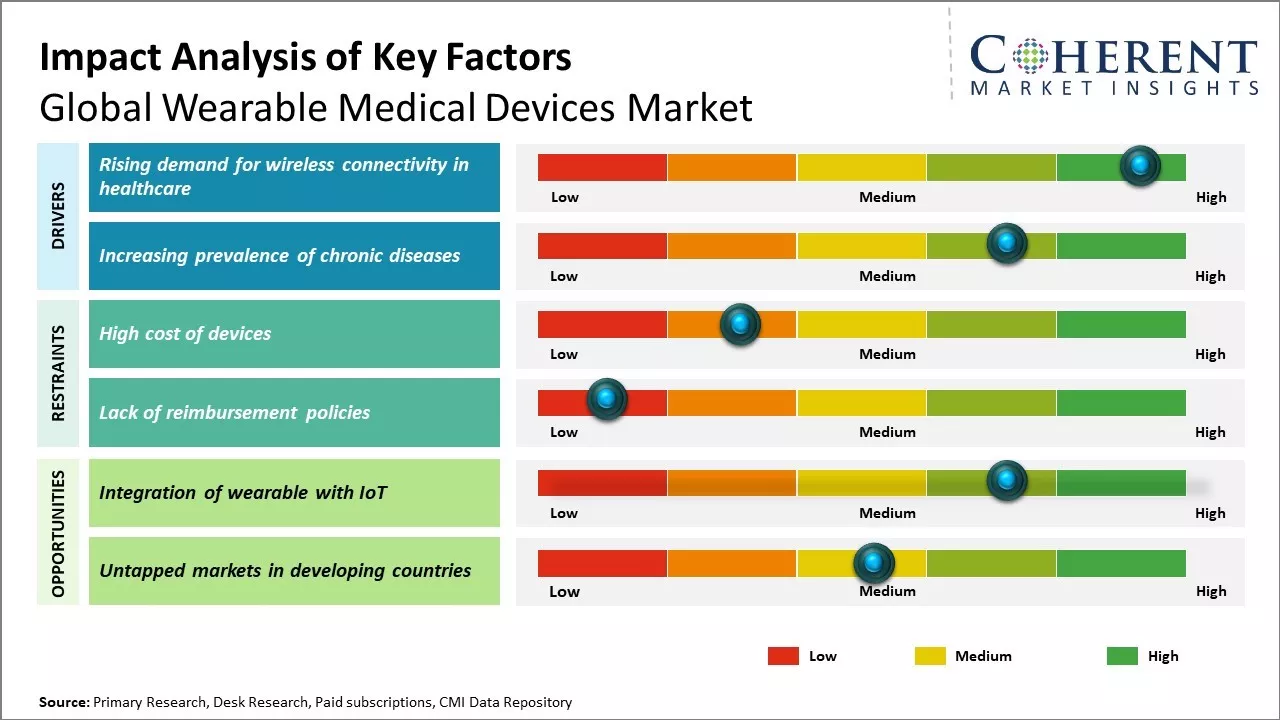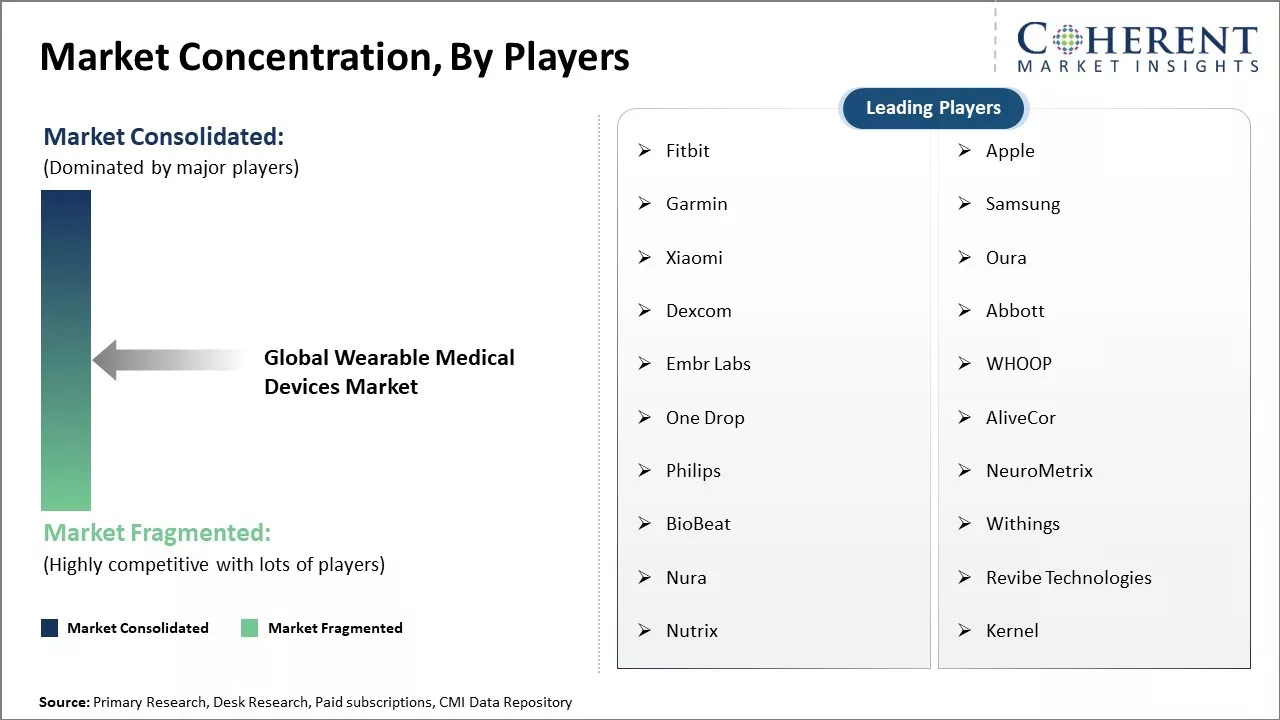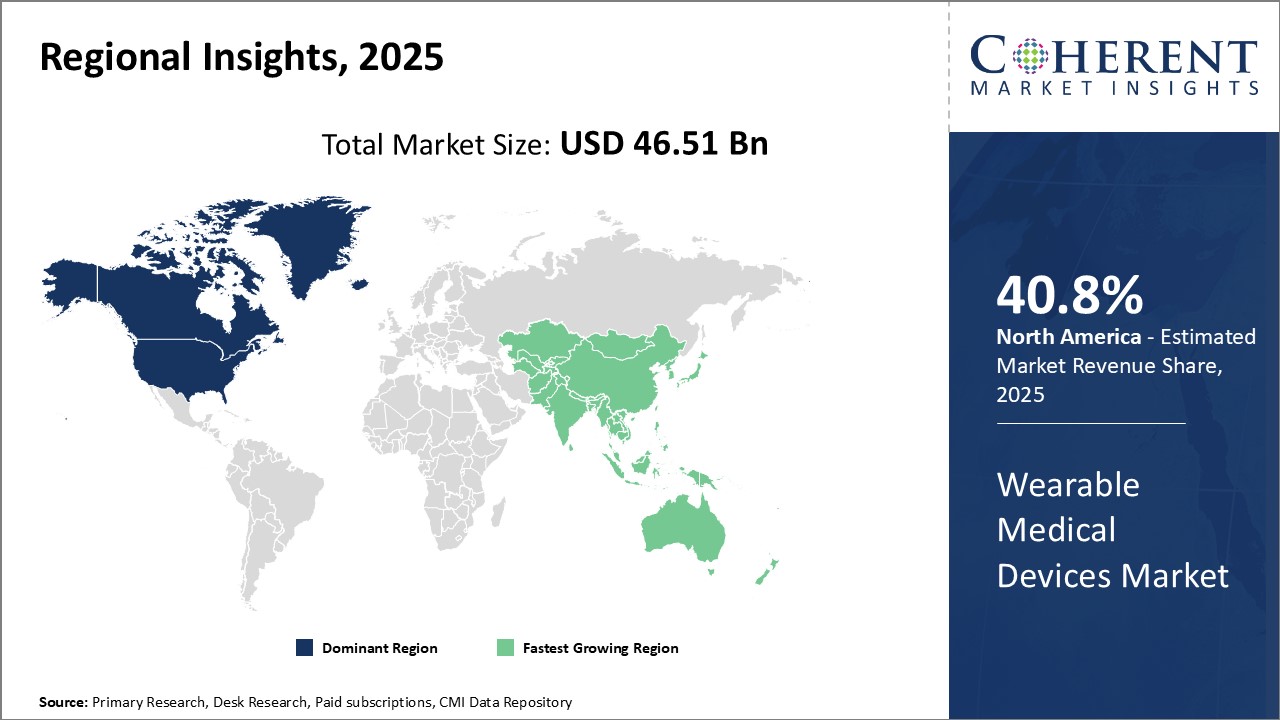Global wearable medical devices market is estimated to be valued at USD 46.51 Billion in 2025 and is expected to reach USD 130.75 Billion by 2032, exhibiting a compound annual growth rate (CAGR) of 15.9% from 2025 to 2032.

Discover market dynamics shaping the industry: Request sample copy
Global wearable medical devices market growth is driven by factors like growing preference for home healthcare devices and remote patient monitoring. Rising awareness regarding benefits of continuous health monitoring and increasing penetration of 3G and 4G networks enabling remote data transfer can also drive the market growth. Increasing number of product approvals and launches by leading players can also drive the market growth. However, data security & privacy concerns and lack of reimbursement policies in certain regions can hamper the market growth. Emerging economies with high unmet needs can offer new opportunities for market players in the near future.
Rising demand for wireless connectivity in healthcare
With advancements in wireless communication technologies, there has been a paradigm shift towards remotely monitoring patients' health data in real time. Wearable medical devices enable the collection of diverse health parameters without restricting the patient's movement or requiring them to stay at a medical facility. This wireless connectivity allows doctors to closely track patients even when these are not physically present. Growing use of technologies like Bluetooth, Wi-Fi, and mobile networks usher wearable medical devices into mainstream healthcare. Devices like wireless pulse oximeters, ECG monitors, and blood pressure cuffs are becoming popular choices for remotely collecting patients' vital signs from the comfort of their own home. This is beneficial especially for elderly people or those recovering post-surgery who need regular supervision. The remote data transmission capabilities are empowering physicians to intervene promptly in case of any emergency. It also help to manage chronic conditions in a more efficient manner without requiring frequent hospital or clinic visits. Wireless connectivity plays a key role in enabling the shift towards preventive and remote healthcare delivery models.
With the widespread adoption of smartphones, cloud computing and telehealth services, patients are now increasingly connected and informed. These expect their care to seamlessly integrate the latest digital technologies for improved management and monitoring. Rising consumer demand can boost innovation in wireless wearable medical devices. Various startups are capitalizing on this need by developing smart garments, patches and sensors for ambulatory monitoring. Healthcare providers are also integrating such wearable technologies into their virtual care offerings to enhance patient outcomes. As remote patient monitoring gain popularity, the wireless capabilities of wearable medical devices will boost its adoption worldwide.

Get actionable strategies to beat competition: Request sample copy
Increasing prevalence of chronic diseases
Rising non-communicable chronic ailments like cardiovascular diseases, diabetes, hypertension, and others pose a serious global healthcare challenge. It has become imperative for physicians to adopt preventive strategies in addition to curative treatments to better manage these prolonged conditions. Wearable medical devices facilitate proactive supervision of chronic patients outside of clinical settings. For instance, devices that can continuously track vital parameters like blood sugar levels, ECG readings, blood pressure enable close monitoring of high-risk individuals. This helps in timely detection of abnormalities and encourages patients to stick to their prescribed medication and therapy regime. Physicians find remote access to longitudinal health data, extremely valuable in assessing a condition's progression or response to interventions over extended periods. It equips them to proactively engage with non-compliant cases and prevent adverse events. Furthermore, wearable technologies are empowering chronic patients to play a pivotal role in self-care. Devices along with accompanying apps make it convenient to log meals, medications, activities and share all health data with caregivers. Over time, patients develop better self-awareness and learn to correlate external factors with changes in their condition. This self-monitoring aspect along with timely medical guidance can improve clinical outcomes especially for conditions necessitating lifelong management like diabetes, COPD, and others.
Key Takeaways from Analyst:
Global wearable medical devices market growth is driven by factors like increasing focus on self-health management by consumers and growing prevalence of chronic diseases worldwide. Wearable devices allow for continuous monitoring of vital signs which enables early detection of health issues. As population ages globally, there is huge demand for remote patient monitoring.
North America currently dominates the market due to early technology adoption and supportive regulations. However, Asia Pacific is expected to be the fastest growing market due to the massive untapped opportunities in countries like China and India which are marked by a booming middle class and younger demographic. Rising healthcare infrastructure and out-of-pocket spending on healthcare in Asia can drive the market growth
While continued miniaturization of sensors allows for more discreet and comfortable devices, data privacy and security concerns can hamper the market growth. Successful devices must gain user trust on protection of sensitive health data from theft or unauthorized access. Regulatory uncertainty also inhibits physician adoption of certain wearable devices. High device costs can hamper the market growth, particularly in price sensitive developing regions.
Innovative product launches focusing on unmet needs, strategic partnerships between device makers and payers, and increased accuracy/features at affordable prices can offer opportunities in the near future. Widespread smartphone penetration also facilitates seamless
Market Challenges: High cost of devices
Global wearable medical devices market growth can be hampered due to high device costs. These devices use advanced technologies such as miniaturized sensors, processors and wireless connectivity, which makes the manufacturing costs quite high. Moreover, R&D investment required to develop these devices also increases the devices pricing. This high pricing puts wearable medical devices out of reach for common consumers and limits their mass adoption. Many insurance providers also do not cover the costs of such devices, which are considered as not medically necessary by some. The high costs act as a barrier for wider acceptance and uptake of wearable technologies for both healthcare providers and patients. For the market to grow sustainably, bringing down the device prices will be crucial through technologies improvements, economies of scale and new business models.
Market Opportunities: Integration of wearable with IoT for market
The integration of wearable medical devices with Internet of Things (IoT) can offer opportunity for market expansion. Connecting these devices to each other as well as to other digital health platforms via IoT maximizes their functionality. It allows continuous monitoring of vital signs and real-time transmission of clinical grade data to caregivers. The data collected can further be analyzed for predictive diagnosis, monitoring of chronic conditions and development of personalized treatment plans. Integration with IoT also facilitates access of medical records to remote healthcare providers. This saves costs and time while improving access and outcomes. With growing IoT adoption, there is potential to develop smart interconnected healthcare ecosystems coordinated by wearable devices. This can revolutionize patient care management as well as create new revenue streams for market players.

Discover high revenue pocket segments and roadmap to it: Request sample copy
By Product Type- Growing Prevalence of Chronic Diseases Boosts Demand for Wearable Therapeutic Medical Devices
In terms of product type, wearable therapeutic medical devices segment is estimated to contribute the highest market share of 45.6% in 2025, owing to growing prevalence of chronic diseases globally. With rising healthcare costs, patients are increasingly opting for wearable therapeutic devices that offer greater convenience and ease of use for long-term management of their conditions at home. Devices such as insulin pumps, respiratory therapy equipment, and sleep apnea monitors allow patients to stabilise chronic diseases like diabetes, COPD and sleep disorders outside of clinical facilities, improving their quality of life. Furthermore, aging population prone to multiple morbidities also boosts demand for easy-to-use wearable therapeutic equipment that can help avoid frequent hospital visits. Technological advancements enable miniaturisation and integration of more diagnostic and therapeutic functionality into compact wearable formats preferred by users. Growing chronic illnesses combined with advancement of wearable technology drives the segment growth.
By Application- Remote Monitoring Applications Excel in Catering to Needs of Aging Population
In terms of application, remote patient monitoring segment is estimated to contribute the highest market share of 32.5% in 2025, due to growing focus on elderly care. With rising elderly demographic worldwide, healthcare systems are increasingly overburdened and costs are escalating. Remote patient monitoring allows the aging population to live independently for longer while still having their vital signs tracked regularly. This frees up expensive hospital resources for critical cases. Applications such as wearable cardiac and pulse oximetry devices remotely transmit health data to clinicians, alerting them of any anomalies or deterioration in status. Such constant supervision reassures both patients and caregivers, avoiding unnecessary trips to hospitals or care facilities. It also helps physicians optimise treatment plans in real-time. Growing acceptance of remote patient monitoring stems from its ability to address the unique needs of an expanding geriatric segment.
By End User- Hospitals and Clinics Account for Bulk Adoption Due to Clinical Requirements
In terms of end user, hospitals and clinics segment is estimated to contribute the highest market share of 52.5% in 2025, owing to stringent regulatory needs. For clinical use, wearable medical devices need to pass rigorous validation and meet safety, efficacy as well as data security standards. These are also usually more expensive than consumer versions due to additional features required in hospital settings. While remote patient monitoring opens up opportunities beyond clinical boundaries, inpatient and surgical care rely heavily on specialized equipment certified for medical use. Hospitals and clinics account for the bulk of adoption as these can best address regulatory compliance and budgets for clinical-grade wearables. Physicians also prefer clinically-validated brands that offer dedicated after-sales support compared to business models focused on individual users. The clinical testing, protocols and infrastructure established by healthcare facilities drive their prominence as end users for wearable medical technology.

Need a Different Region or Segment? Customize now
North America is expected to be the dominant region in the global wearable medical devices market with an estimated market share of 40.8% in 2025, due to the strong presence of leading medical device manufacturers as well as the high adoption rates for cutting edge wearable technologies in this region. The U.S., in particular, is home to many innovative companies that are pioneering the development of advanced wearables for health monitoring. With its large patient population and well-developed healthcare infrastructure, North America provides a fertile environment for new wearable offerings to gain popularity. Favorable reimbursement policies for digital health solutions have also accelerated market growth. Export of North American-made wearables to other global markets has also contributed significantly to the regional leadership position.
Asia Pacific has emerged as the fastest growing regional market. Countries like China, Japan, South Korea and India have demonstrated high enthusiasm for wearable devices both among consumers as well as healthcare providers. This is evident from rising imports of internationally branded products in Asia Pacific. Furthermore, domestic manufacturers have increased their investments in wearables R&D to become prominent global players. Their ability to offer cost-competitive solutions without compromising on quality has attracted considerable interest. Strong support from governments aiming to modernize public health programs through digital technologies also drives the market growth. With burgeoning middle-class populations and huge unmet medical needs, Asia Pacific offers a highly promising outlook for the long-term worldwide prospects of wearable medical devices industry.
Wearable Medical Devices Market Report Coverage
| Report Coverage | Details | ||
|---|---|---|---|
| Base Year: | 2024 | Market Size in 2025: | USD 46.51 Bn |
| Historical Data for: | 2020 To 2024 | Forecast Period: | 2025 To 2032 |
| Forecast Period 2025 to 2032 CAGR: | 15.9% | 2032 Value Projection: | USD 130.75 Bn |
| Geographies covered: |
|
||
| Segments covered: |
|
||
| Companies covered: |
Fitbit, Apple, Garmin, Samsung, Xiaomi, Oura, Dexcom, Abbott, Embr Labs, WHOOP, One Drop, AliveCor, Philips, NeuroMetrix, BioBeat, Withings, Nura, Revibe Technologies, Nutrix, Kernel |
||
| Growth Drivers: |
|
||
| Restraints & Challenges: |
|
||
Uncover macros and micros vetted on 75+ parameters: Get instant access to report
*Definition: The global wearable medical devices market consists of any electronic device or product that is worn on the body as an accessory or as part of material worn and is able to monitor some function or condition of the body and relay that information to the user or healthcare provider. This includes devices such as wearable heart rate, glucose, and oxygen saturation monitors as well as digital transcutaneous electrical nerve stimulators and medical exoskeletons that can assist with mobility for those with injuries or disabilities.
Share
Share
About Author
Manisha Vibhute is a consultant with over 5 years of experience in market research and consulting. With a strong understanding of market dynamics, Manisha assists clients in developing effective market access strategies. She helps medical device companies navigate pricing, reimbursement, and regulatory pathways to ensure successful product launches.
Missing comfort of reading report in your local language? Find your preferred language :
Transform your Strategy with Exclusive Trending Reports :
Frequently Asked Questions
Joining thousands of companies around the world committed to making the Excellent Business Solutions.
View All Our Clients
US Reciprocal Tax Impact Analysis On Wearable Medical Devices Market
Stay updated on tariff changes with expert insights and timely information